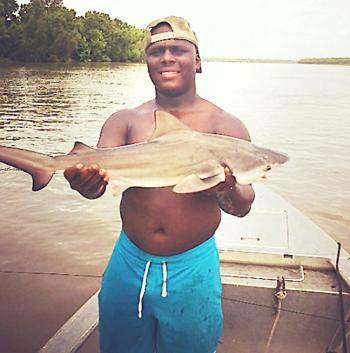
Jordan Minor, 16, of Morgan City got a surprise when he pulled up his trotline in late June — a three-foot bull shark. He caught the shark in the Atchafalaya River in Morgan City where he later released it, he said.
(Submitted Photo)
Bull shark caught near Morgan City
Sixteen-year-old Jordan Minor got a surprise when he pulled up his trotline in late June — a three-foot bull shark.
“It kind of freaked me out at first. Me and my buddy were just running our trotlines and I thought it was a catfish and when I pulled the hook up, I saw it was a shark,” Minor said.
He and Ethan Aucoin, 16, of Centerville, were fishing in the Atchafalaya River near Morgan City when the shark was caught, Minor said.
Nicole Cotten, Louisiana Universities Marine Consortium university education coordinator; David L. Schultz from Nicholls State University’s Department of Biological Sciences; and Kerry St. Pé, formerly director of the Barataria-Terrebonne National Estuary Program, identified the catch as a bull shark.
The only shark that regularly enters very low salinity waters in Louisiana is the bull shark, Schultz said.
St. Pé said “they do get high up into fresh water and can be aggressive.”
Cotten said there are records of this variety of shark going as far north as Illinois.
“They tend to spend their lives in salt water, but they can move upriver,” Cotten said.
Minor said it was the first time he’d seen a bull shark in the area he fishes. This is the first year he and Aucoin have run trotlines, previously opting for fishing poles after they were done running their crawfish traps for the day.
According to an LSU AgCenter fact sheet on bull sharks, they often are called “sand sharks,” a catchall term for any small shark. “Worldwide, over 350 species of sharks exist; not one of them is a species called a sand shark,” the fact sheet states.
Large female bull sharks seek out estuaries and river mouths to bear their one to 10 live young, typically between April and June. “The pups measure 29 inches at birth and are born fully armed with teeth. They stay in low-salinity waters about six years, feeding and growing until 4- to 5-feet in length. Bull sharks will grow to 11-feet-long and live at least 20 years,” according to the fact sheet.
Cotten said people have been attacked by bull sharks in fresh water but “it’s not a common thing.”
Her safety tips included not wearing shiny jewelry while swimming and not swimming at dusk and dawn when sharks are feeding.
- Log in to post comments
